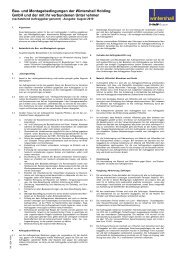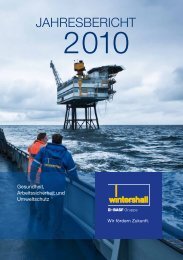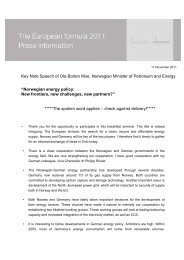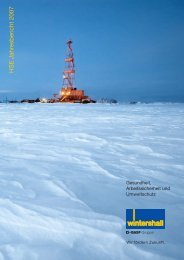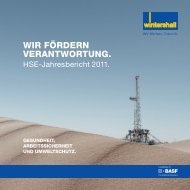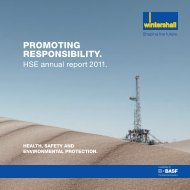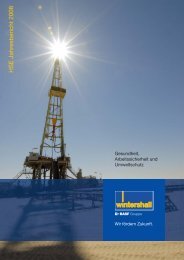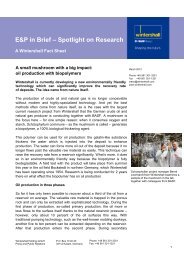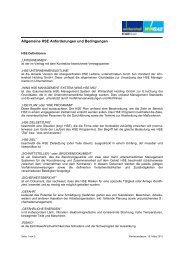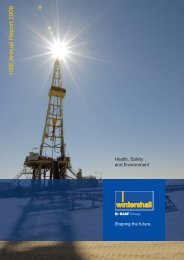HSE Annual Report 2010 (English) - WINTERSHALL
HSE Annual Report 2010 (English) - WINTERSHALL
HSE Annual Report 2010 (English) - WINTERSHALL
You also want an ePaper? Increase the reach of your titles
YUMPU automatically turns print PDFs into web optimized ePapers that Google loves.
GERMANY: MICROTUNNEL – WORKING IN COM-<br />
PRESSED AIR CONDITIONS.<br />
The Baltic Sea Pipeline Link (OPAL) will pass below<br />
the River Peene via a microtunnel that was drilled<br />
in a depth of up to 25 meters. This method was<br />
chosen to protect the sensitive countryside and<br />
surrounding nature reserve. A tunneling machine<br />
with a diameter of three meters was used to drill a<br />
tunnel from the entry pit to the exit pit 1,000 meters<br />
away. As the machine advanced, 4-meter concrete<br />
segments were inserted in the tunnel. At the completion<br />
of the tunnel, the pipes for OPAL, which had been<br />
welded together beforehand, were drawn in.<br />
The discovery of a granite erratic boulder of around<br />
three meters in diameter after 650 meters of drilling<br />
resulted in the cutting tools having to be replaced<br />
on the drill head at a depth of around 22 meters.<br />
The position below groundwater level was a<br />
challenge. Due to the prevailing conditions in the<br />
subsoil, the tool had to be replaced with the front<br />
section of the tunnel pressurized using compressed<br />
air. This ensured stability, enabled access and prevented<br />
an excessive influx of groundwater. Extensive<br />
sealing work for the tunnel and surface were<br />
necessary to make the working area air-tight. The<br />
pressure at the drill head was 2.3 bars, equivalent<br />
to that when diving at a depth of 20 meters. Consequently,<br />
special compressed air equipment was<br />
needed to ensure safe working conditions and<br />
minimize the physical strain and stress. The technicians<br />
worked in three shifts, each lasting 2.5<br />
hours; it also took around 3 hours to prepare the<br />
workers for the face and another 3 hours to return<br />
them to the surface in a compression chamber.<br />
The entire work program was supervised by an<br />
occupational physician and coordinated by a team<br />
of professional divers.<br />
HEALTH SAFETY ENVIRONMENT <strong>2010</strong>



